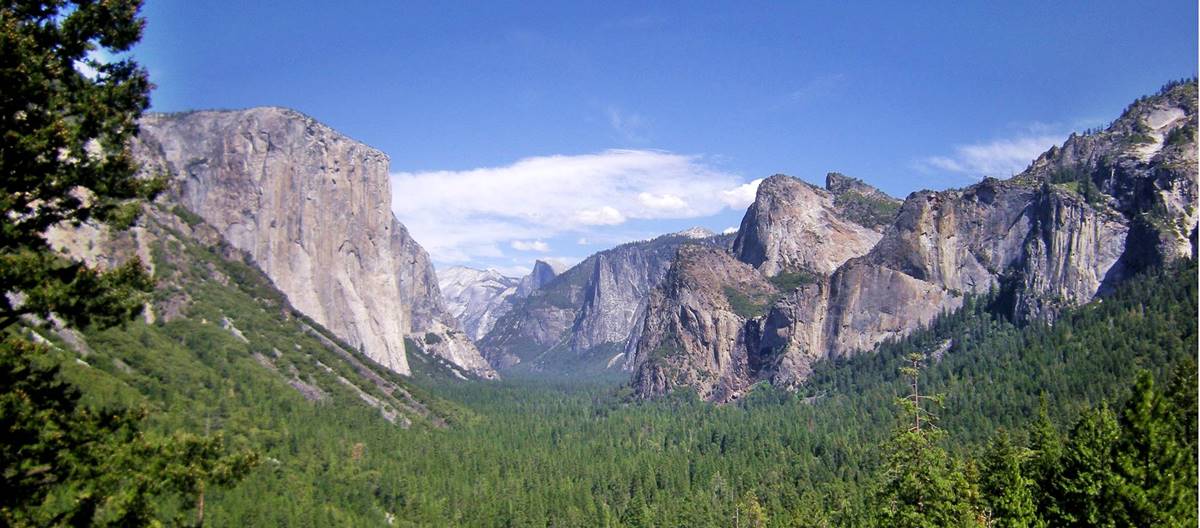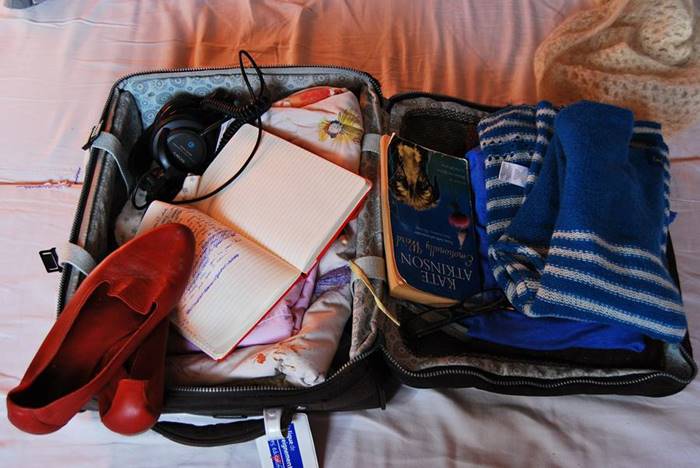How to Plan a Trip
Definition of Plan:
"Noun. A set of actions that have been thought of as a way to do or achieve something"
Vacations Planning made easy
Just like you would do for any other important activity (and vacations are very important), you will have to gather information and do your homework: research, read about your destination, jot down the tips and suggestions shared by other travellers and learn more about the attractions that you will enjoy during your holidays.
Actually, planning a trip is part of the fun. It is said that "You travel three times: once when you plan it, twice when you live it, and a third time, when you remember it".
The four steps that we outline below will hep you design the perfect Vacation:
This step-by-step checklist will help you to outline your journey and consider everything that you should take into account.
How to Plan a Trip
Step-by-step List
1. Collect information and analyse it
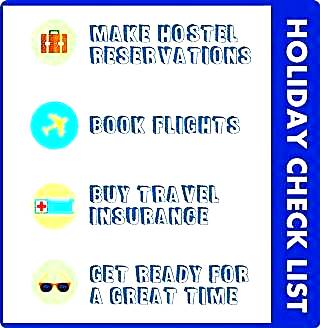
You should first learn about your destination: What are the main sights and attractions? What sort of weather will you encounter? How will you get there? How will you move about once your reach your destination?
Check a map and locate your destination. Identify the main places you will want to visit in the town or the region. Locate the nearest railway station or airport, you will need them to plan your trip.
If you have friends who have gone to this destination, ask them about their experience both planning their trip and enjoying it, and also, what they would have skipped and what they are sorry they did'nt do during their vacations.
Write a rough outline of the trip, and a "wish list" of must-see sights and things to do
Travel abroad: Visas
If you are travelling abroad, you may require a Visa to enter the country that you will be visiting. The best source for complete and accurate information regarding the visa requirements is that country's embassy or consulate in your home country.
Their embassy's web pages may also provide reliable information. Bear in mind that rules are continuously evolving and are also quite complex. So do a full research to find out exactly what you will need to secure a visa for your Trip.
There are many kinds of visas. The one that you will need for your trip is surely a "Tourist Visa", which is, by the way, the easiest to obtain. They usually allow you to visit a country fo up to three (3) months and remember that you cannot work in that country with this type of visa.
You will have to apply for a visa at the embassy or consulate in your home country. The process will involve paying a visa fee and filling in a form. It can take some time so consider this when you plan your trip (a visa taking 2 weeks may ruin your trip if you apply for it the day before you leave).
Step 1 outcome: A first rough oultine of your trip
You now have a rough outline of your destination, its attractions, landmarks, must-see places and things you can do there. Now you can write down an initial draft of your trip plan.
The next step will be to try to fit your initial plan into your allocated time frame, see Step 2 below
Step 2. Time needed for your Trip
How much time can you spare? Your trip will change depending on the available time you have. But don't be discouraged, a one-week or a one-month trip can be planned so that you can pack as much fun and adventure as possible into them; it all depends on how you plan your journey.
Getting there
In step one you defined potential arrival points (nearby towns with airports or train stations -or ferry ports or bus stations). Now it is time to start thinking about getting from your home to your destination and from there back home again (or, how to reach your second destination, if your trip involves more than one destination).
Factor in the time it will take you to get to your destination. A visitor from the UK traveling to Patagonia will need to calculate the flight times from Britain to Buenos Aires, Argentina, ahd then add the connecting flight from there to the point where you will actually start your trip. And then, the return flights to get back home. Calculate the time you will need to "get to and from your destination".
Now you can calculate how many days you will actually have for your trip, knowing:
- How much time you have for your trip (i.e. 15 days)
- How long it will take you to go and come from your destination (i.e. 2 days)
In this example you have 13 days for your vacation. So you will need to calculate 13 hostel nights during your trip.
Step 3. Calculate a Budget
How much will the trip cost? You must have a reasonable idea of the cost of your road trip. Take into account the following:
Getting There
The cost of reaching your destination (and getting back home after your trip) depends on whether you will fly, bus or take a train. Calculate these costs (air fares, airport taxes, taxi, bus, train tickets etc.)
Accommodation
This is a key element in your budget, and the cost will depend on the season (high or low) and the type of lodging, which of course depends on your budget. There are all kinds of Hostels and they offer different types of accommodation too.
To calculate your lodging costs Check the Hostels that are available on the dates that you have identified in Step 2. This will give you an idea of the cost of your hostels.
Tips for Booking your accommodations
If you plan to travel during the high season summer holiday period, reserve your hostel well in advance. Some key hostels may be fully booked months in advance, so book them with plenty of time.
Travel Insurance
Are you covered? If you are traveling outside of your home country, your health and accident insurance may not cover you.
Your travel insurance should cover cancellations or other travel mishaps.
Food
Calculating the cost of food depends on how you like to eat: Will you eat at restaurants? Fast food or more formal meals? Have both Lunch and Dinner? Buy snacks or stock up at the local supermarket? Eat from food carts and street vendors?
Attractions and admission fees
You will usually have to pay an admission fee at National Parks, Museums and events... calculate these too.
Miscellaneous items
- Always set some cash aside for the unexpected, for souvenirs, emergencies and whaterver may tickle your fancy.
- Don't forget your partying and happy-hour cash. Drinks and nightlife should be considered.
- Outdoors activities; side trips, scuba diving or renting kayaks...
Step 4. Check your Plan again and again
Review your first draft. Get some more details. Add or remove sights and attractions, perhaps give yourself more time to see things, for shopping or to visit some cultural attraction. Factor in some side trip. Read more, and improve the original rough draft.
Review flight options the connecting flights, Check out other hostels.
Planning a trip is part of the fun, it is about the journey not the destination; enjoy the process!
How much should you plan?
Some travelers like to have a very detailed trip plan. This is perhaps a good idea if you have a tight schedule, so that you can optimize your trip.
Others, especially those with more time on their hands, prefer an open plan, and are open to letting the road take them to unexpected destinations.
A middle-of-the-road approach is to outline a general broad idea of your vacation, and then book key hostels with plenty of time. Leave room for unexpected scenic spots that may surprise you along the way.
What to Pack for your trip
Travel Documents
International visitors, will need their passports with an appropriate visa if required. If you plan to rent a car, bring your driving license and an International Driver Permit if applicable.
Make Photocopies of Important Documents like passport and credit cards, if you lose them or they are stolen, the information will be very useful. Pack them separately from the originals.
Medicine and First Aid.
You never need them until you need them! And then you realize how important a good first aid kit is.
- First Aid kit. It should include Band-Aids, bandages, antiseptic, medicine for pain or fever (such as acetaminophen, aspirin, or ibuprofen). Cough drops, lubricating eye drops, tweezers and scissors.
Motion sickness medicine. Antifungal, antibacterial, hemorrhoidal ointments or creams. - Prescription Medicine. Don’t forget your regular medication (bring enough of it to cover your whole trip).
- Other items. Hand sanitizer is useful, lip-balm, bug repellent and very important: sunscreen and a sunburn-relief gel.
If you are allergic, do not forget your allergy medications.
Miscellaneous Items
- Small size laundry soap it comes in handy to wash underwear or socks during your stopovers
- Paper napkins or a roll of toilet paper.
- Zip-loc bags to keep important items dry.
- Wet wipes.
- Keep your coins handy -I carry a small purse. They come in handy at the laundry or street vendors.
- Food. Some healthy and easy to carry food: granola bars, nuts, peanuts, dried fruit, raisins, fresh fruit and water are a must.
- Portable electric water heater; although 99% of the hotels and motels in the US and Canada have an electric coffe maker in your room, I always pack my immersion water heater just in case (for instance, the five star Sofitel in Rio de Janeiro, Brazil did not have an in-room coffee maker during a recent stay there). I also pack a jar of Nescafe instant coffee, a Coffee-Mate and instant soup.
- Masking tape or Duct Tape. A roll of masking tape is handy to seal off the lids of the cosmetics (sun tan lotion, hair conditioner, and the cap of the Coffee-mate, to avoid spills during flights. Duct tape is great for tears and fixing broken shoe soles on the go.
My two pouches
Tools. I carry a small pack with a set of tools: a repair kit for glasses (screws, tiny screwdriver), my Victorinox penknife, a small screwdriver and a multi-purpose triangular pocket tool plus a Stanley multi-tool which I use as a pliers, these items go in my checked-in luggage when I fly. All of this fits into a Lufthansa business class amenity kit pouch, a memento from one of my trips (I have quite a few of them too). It is pictured below:
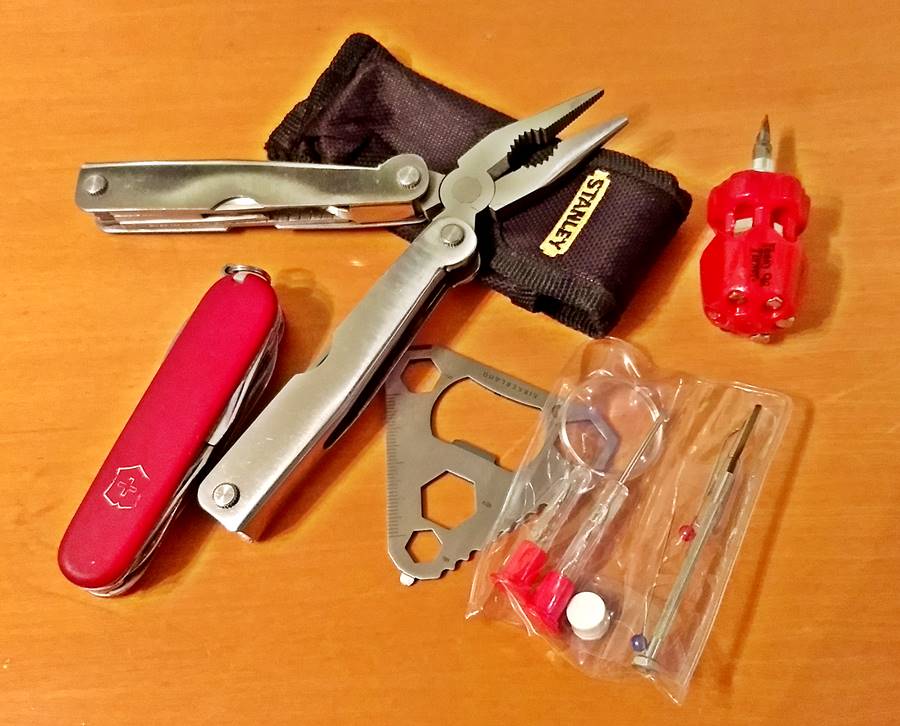
Amenity Kit
Separately I carry another small pouch which is my //b “in-flight amenity kit” I always carry it with me in my backpack and it comes with me when I travel.
I use an old Air France business class pouch which is compact. In my amenity kit I pack the following items:
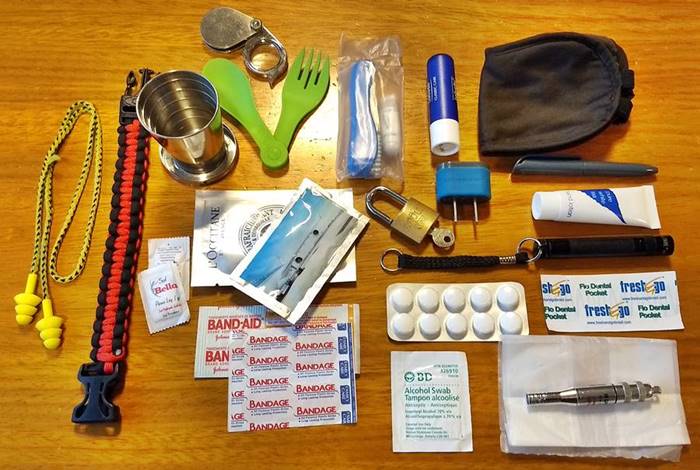
- A small led flashlight that works on an AAA battery
- Mint flavored chewing gum
- Mini Ballpoint Pen (for filling in customs or immigration forms)
- Small tooth brush and tooth paste and dental floss
- Aspirin (a blister strip)
- Small plastic bag
- Foldable plastic spoon & fork
- reusable ear plugs with a cord
- Lifesaving Braided Rope Tactical Wrist Band with whistle (I love it!)
- Stainless Steel Telescopic Collapsible Cup (75 ml) (souvenir from a trip to Switzerland)
- tiny padlock
- Adhesive bandages (Band-Aid)
- eye shade
- Whistle
- Wipes (from previous flights) and an alcohol swab
- Candies
- Tea bag and Non-dairy creamer pack
- hand cream and lip balm
- Some packets of salt
- Magnifying glass
- Tiny packed bar of soap
- Toothpick
- Adapter (to American electricity outlets)
The in-flight kit is completed with three other items:
- Water bottle (I either carry an empty one and fill it up at a fountain in the airport after security clearance or buy one after the security check).
- Wide headband (which I wear as a neck warmer)
- Socks (comfy and soft)
Clothes
Think weather: will it be hot or cold, rainy or sunny? Winter or Summer. Prepare for the weather you may encounter along the road. Dress comfortably for the road trip.
I pack two pairs of Columbia’s convertible pants, they are comfy, light-weight, hardy and let me unzip the legs to turn them into a pair of mid length shorts. They are easy to wash, they dry in a jiffy and don’t need to be ironed.
They have pockets for my glasses, smartphone and wallet.
Pack a windjammer or a sweater. Cap or hat to fend off the sun. Don’t forget a swimsuit.
Pack the basics, in colors that can combine easily. If you spend more than a week traveling you will need to wash your clothes, I carry a trash (garbage) bag and stow my dirty laundry in it, separate from my clean clothes.
Book lodging at a hostel that has laundry facilities or ask for a Laundromat when you reach your destination. Lightweight quick-drying clothes are also handy should you choose to wash your clothes at the hostel.
Gear
- Hiking poles (are you into trekking? Then don’t forget your hiking boots.)
- Sunglasses
- Chargers, for your smartphone, your camera, tablet. A USB cable, power cords, socket adapter, spare battery for cameras and smartphones.
Tips for Healthy and Safe Travel
To Do Before you travel
- Health conditions. If you have a health condition (heart, diabetes, asthma, etc.), check with your doctor before you travel. He may have advice on what you should or should not do.
- Medical History. Prepare a brief medical history and carry it with you: your doctor’s contact information, your allergies, blood type, prescription medications, etc.
- Your shots. For the Europe or the US you don’t require special vaccines (like Yellow Fever for South Africa or India) but I always have a flu shot in fall -have you ever been down with a fever during your holidays? It's awful.
- Medical Insurance. Get travel insurance that has medical coverage hat covers emergency evacuation for medical care. Carry the contact details of your insurance with you.
- Prescriptions. Ask your doctor to issue prescriptions for the medications that you may need during your whole trip, if you are an international visitor you may not be able to buy them locally
Carry the essential medications in your carry-on luggage. Keep your medicine in its original packaging, you may need a letter from your MD explaining the need for certain medicines. - Glasses. If you wear glasses, pack an extra pair of glasses.
During your flights
- Avoid alcoholic drinks and coffee. Keep hydrated; drink plenty of water. Eat sparingly. Try to sleep and readjust to the local time when you arrive to avoid jet lag.
- Read our article about Why does flying wear you out?.
- Follow the on board exercise programs to keep blood clotting in your legs to a minimum. Walk about, stretch: Deep Vein Thrombosis or DVT affects 1 out of every 6000 people who fly and can cause pain, serious trouble and even death.
Air travel compression socks may help prevent them. I also take an aspirin before flying (though it is not proven that its blood-thinning effect may help to prevent DVT).
The most serious complication of DVT is a pulmonary embolus, that is, a blood clot breaking away and heading to your lungs where it can cause death.
Also note that persistent calf symptoms may occur after a DVT.
During your Vacations
- Don’t ever touch wild animals. Even cute squirrels can bite and have plague or rabies.
- Use sunscreen and insect repellant (ticks transmit Lyme’s disease and mosquitos can give you malaria, yellow fever, dengue, zika, or chikungunya - read about the diseases of the country that you will be visiting).
- Wash your hands frequently (I carry hand sanitizing wipes which I also use at the hostels to clean the TV’s remote control, the air conditioner control and the room’s phone). According to a scientific paper published in 2012, remote controls are one of the most contaminated objects in hotels & Hostels together with the bedside lamp switch.
- Keep healthy habits: eat fruit, whole grains, lean meats and vegetables. Sleep well. Do not skip breakfast.
Stop along the way to relax and unwind, take in the scenery, the people, experience the moment.
Improve your Plan for the future
So enjoy your trip and pack smart and travel light. Write down that thing that you should have brought with you and forgot to! and those that you didn't really need. That wasy you can bring them with you (or leave them behind) the next time.
Bon Voyage!
